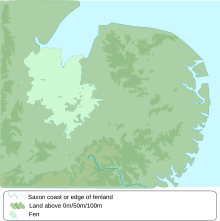Crowland Abbey facts for kids
Quick facts for kids Crowland Abbey |
|
|---|---|

Crowland Abbey
|
|
| Denomination | Church of England |
| Churchmanship | Broad Church |
| Website | crowlandabbey.org.uk |
| History | |
| Dedication | Blessed Virgin Mary, Saint Bartholomew and Saint Guthlac, |
| Administration | |
| Parish | Crowland |
| Deanery | Elloe West |
| Diocese | Lincoln |
| Province | Canterbury |
Crowland Abbey (also spelled Croyland Abbey) is a very old Church of England church. It was once part of a large Benedictine abbey (a place where monks live). You can find it in Crowland, a town in Lincolnshire, England. This historic building is so important that it's listed as a Grade I building.
Contents
History of Crowland Abbey
How the Abbey Started
A monk named Guthlac came to this area around 699 AD. Back then, it was an island in the Fens, a marshy region. He chose to live there as a hermit, a person who lives alone for religious reasons. Guthlac lived there until 714 AD.
After Guthlac, other monks followed his path. A group of monks started living here in the 8th century. Croyland Abbey was dedicated to Saint Mary the Virgin, Saint Bartholomew, and Saint Guthlac.
Important People and Changes
In the late 900s, a nobleman named Turketul became involved with Crowland. He was related to the Archbishop of York. Turketul became the abbot (the head monk) of the abbey. He gave the abbey many lands and properties. Around this time, Crowland likely started following the Benedictine rule. This was a set of guidelines for how monks should live.
In the 11th century, a famous English rebel named Hereward the Wake lived on land owned by the abbey.
The Abbey's End and Damage
In 1537, the abbot of Crowland tried to save his "poor House" by sending a gift of fish to Thomas Cromwell. Cromwell was a powerful advisor to King Henry VIII. However, the abbey was still dissolved (closed down) in 1539. This was part of the King's plan to close all monasteries in England.
After the closure, many parts of the abbey were quickly pulled down. This included the chancel, transepts, and crossing of the church. But the main part of the church, called the nave and aisles, was used by local people. It continued to be their parish church.
During the English Civil War (1642-1651), the abbey ruins were used as a fort. Soldiers loyal to the King (called Royalists) defended it in 1642. But in May 1643, soldiers loyal to Parliament (called Parliamentarians) attacked and took it. This attack, led by Oliver Cromwell, caused serious damage to the abbey.
The roof of the nave fell in 1720. The main south wall was taken down in 1744. Today, only the north aisle of the nave is still used as the parish church. It has been repaired and is still an active church.
The Croyland Chronicle
Crowland Abbey is famous among historians for the Croyland Chronicle. This was a historical record started by one of its monks. Other monks continued to add to it over time. It tells us a lot about the history of the abbey and England.
The Skull of Abbot Theodore
The church has a skull that is believed to be from Abbot Theodore. He was an abbot in the 9th century. Stories say he was killed at the altar by Viking invaders. This skull used to be on display for people to see. But it was stolen from its case in 1982. Luckily, it was returned anonymously in 1999.
Crowland Abbey in Poetry
The poet John Clare wrote a poem about Crowland Abbey. It was a sonnet (a 14-line poem) called 'Crowland Abbey'. It was first published in 1828.
Organ
The abbey has a small pipe organ. It has two keyboards, called manuals. You can find more details about this organ on the National Pipe Organ Register.
Bells
Crowland Abbey is said to have been one of the first churches in England to have a set of tuned bells. This happened around 986 AD. The Croyland Chronicle claims that Abbot Egelric, who died in 984, provided these bells.
The chronicle says he had two large bells named Bartholomew and Bettelm. He also had two medium bells named Turketul and Tatwin. And two small ones named Pega and Bega. Before this, Abbot Turketul had made one very large bell called Guthlac. When all these bells were rung together, they made a beautiful sound. The chronicle says there was no other set of bells like it in all of England back then.
However, historians now think that the stories linked to Abbot Ingulf were actually written much later, in the 14th century. This makes the charming story about the bells' origin less certain.
What we do know for sure is that the current bells at Crowland Abbey were the first to be broadcast on wireless radio by the BBC. This happened on November 1, 1925. The ropes used to ring the bells are 90 feet long. This makes them the longest bell ropes in England!
Burials
The churchyard also contains the war grave of an airman from the Second World War.
Crowland in Fiction
- Potter, Jeremy. A Trail of Blood. (New York: McCall, 1970.)
See also
 In Spanish: Abadía de Crowland para niños
In Spanish: Abadía de Crowland para niños


